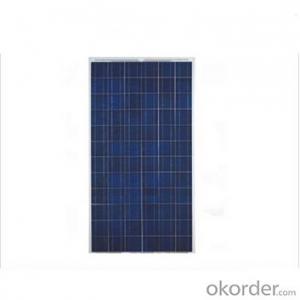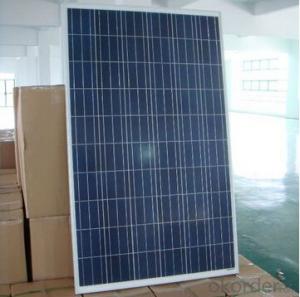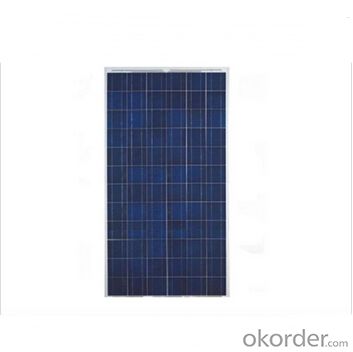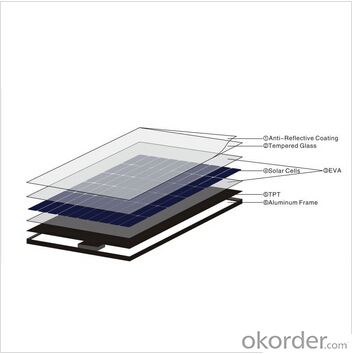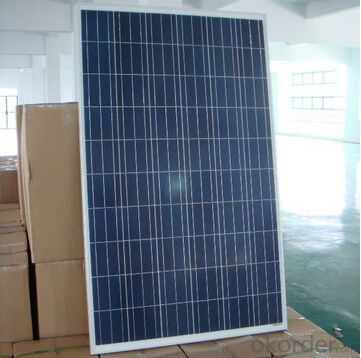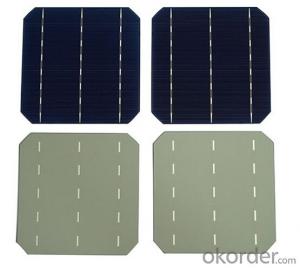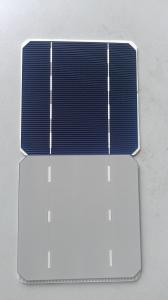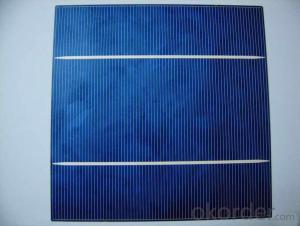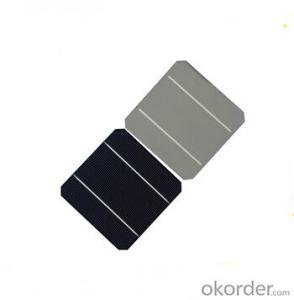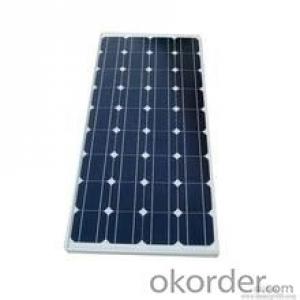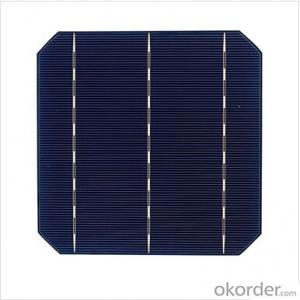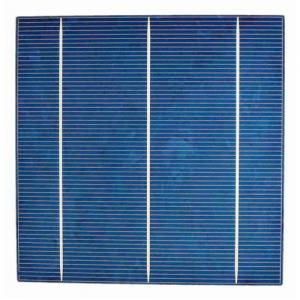Cylindrical Grade-A Monocrystalline Solar Cells
- Loading Port:
- Shanghai
- Payment Terms:
- TT OR LC
- Min Order Qty:
- 50 pc
- Supply Capability:
- 10000 pc/month
OKorder Service Pledge
OKorder Financial Service
You Might Also Like
Product Description:
Solar Monocrystalline Series Panels
Introduction of Solar Monocrystalline Series Panels
CNBM Solar photovoltaic (PV) Panel is designed for large electrical power requirements. It is the optimal choice for both on-grid and off-grid power systems. CNBM Solar panel offers high performance of power per square foot of solar array. Monocrystalline silicon(c-Si): often made using the Czochralski process. Single-crystal wafer cells tend to be expensive, and because they are cut from cylindrical ingots, do not completely cover a square solar cell module without a substantial waste of refined silicon. Hence most c-Si panels have uncovered gaps at the four corners of the cells.
Characteristics of Solar Monocrystalline Series Panels
I Solar Cell : High efficiency crystalline solar cell. Even if under the weak light, the solar module can produce maximum power output.
II Tempered glass (toughened glass): Anti-reflecting coating and high transmission rate glass increase the power output and mechanical strength of solar module.
III EVA and TPT: Using high quality EVA and TPT to prevent destroying and water.
IV AI frame: Without screw, corner connection. 6 holes on the frame can be installed easily.
V Junction box: Multi function junction box with water proof.
VI Long lifetime: ≥25 years; Less power decrease
VII Good performance of preventing from atrocious weather such as wind and hails.
VIII Resisting moisture and etching effectively, not effected by geology.
Standard Test Conditions of Solar Monocrystalline Series Panels
The opto-electrical specifications shown below are stabilized values being measured at Standard Test Conditions, Irradiance: 1000W/m2, Spectrum: AM1.5 at 25°C, The info below is subject to manufacturing tolerances. Where appropriate minutes of measurement are available and are used for the dimensioning of the installation.
Advantages of Solar Monocrystalline Series Panels
• CNBM Solar performance guarantees for 25 years
• 12 years guarantee for workmanship
• Timeliness of delivery
CNBM International Corporation's products including Monocrystalline Solar Panel, Polycrystalline Solar Panel have received and enjoyed famous reputation in many countries and regions in the world .As a solar panel supplier in China, we strive to provide our customers with excellent service, superior products and unmatched value.
Characteristics of Solar Monocrystalline Series Panels
Max Power Voltage Vmp (V) | 18.4V | 17.6V |
Max Power Current Imp (A) | 6.52A | 7.39A |
Open Circuit Voltage Voc (V) | 23.0V | 22.2V |
Short Circuit Current Isc (A) | 6.97A | 7.90A |
Max Power Pm (W) | 120W | 130W |
Temperature Coefficient of Cells
NOCT | 47℃±2℃ |
Temperature Coefficients of Isc (%/℃) | 0.064 |
Temperature Coefficients of Voc (%/℃) | -0.33 |
Temperature Coefficients of Pmp (%/℃) | -0.45 |
Mechanical Data Solar Monocrystalline Series
Power | 120W/130W |
Dimension | 1190/1470×670×30mm |
Weight | 9.5kg/11.7kg |
Tolerance | ±3% |
The dimension of the modules can be changed according to the demand of clients
Limits
Operating Temperature | –40 °C to +85°C |
Storage Temperature | –40 °C to +85°C |
Max System Voltage | 700V |
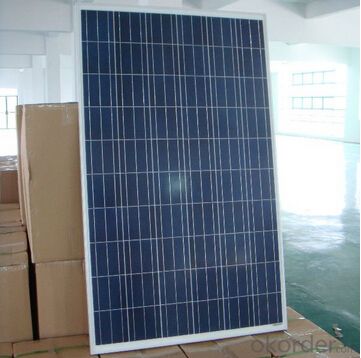
FAQ
We have organized several common questions for our clients,may help you sincerely:
1. What’s price per watt?
A: It’s depends on the quantity, delivery date and payment terms of the order. We can talk further about the detail price issue. Our products is high quality with lower price level.
2. Can you tell me the parameter of your solar panels?
We have different series of cells with different power output, both from c-si to a-si. Please take our specification sheet for your reference.
3. How do you pack your products?
We have rich experience on how to pack the panels to make sure the safety on shipment when it arrives at the destination.
4. Can you do OEM for us?
Yes, we can.
5. How long can we receive the product after purchase?
In the purchase of product within three working days, We will arrange the factory delivery as soon as possible. The perfect time of receiving is related to the state and position of customers. Commonly 7 to 10 working days can be served.
- Q: What is a polycrystalline solar cell?
- A polycrystalline solar cell is a type of solar cell that is made up of multiple crystalline silicon grains. It is formed by melting and solidifying silicon into a block, resulting in a material with a random arrangement of crystal structures. This type of solar cell is less expensive to produce compared to monocrystalline solar cells, although it typically has slightly lower efficiency.
- Q: Can solar cells be used for cooking?
- Yes, solar cells can be used for cooking by converting sunlight into electrical energy, which can be used to power electric stoves or heat sources for cooking.
- Q: What kind of products can be considered as the solar cell products?
- Solar cell product, as simple as it is, is the products which is made of solar cell, or generated by the power converting from solar cells.
- Q: How do solar cells handle hail or other physical damage?
- Solar cells are designed to be durable and can withstand hail or other physical damage to a certain extent. They are typically made with tempered glass or other strong materials to protect the delicate photovoltaic layers. However, severe hailstorms or significant physical impact can potentially cause damage to the cells, leading to reduced efficiency or complete failure. In such cases, it may be necessary to repair or replace the damaged solar panels.
- Q: Can solar cells be used in electric fences?
- Yes, solar cells can be used in electric fences. Solar cells can convert sunlight into electricity, which can power the electric fence energizer. This eliminates the need for a constant power supply or batteries, making it a sustainable and cost-effective option for powering electric fences.
- Q: How do solar cells perform in different climates?
- Solar cells perform differently in different climates due to variations in sunlight intensity, temperature, and weather conditions. In regions with abundant sunlight and cooler temperatures, solar cells tend to perform optimally, generating higher electricity outputs. However, extreme climates such as very hot or very cold environments can affect the efficiency and lifespan of solar cells. Additionally, cloudy or rainy climates may reduce the overall energy production of solar cells. Despite these variations, solar power remains a viable and increasingly popular renewable energy option in a wide range of climates.
- Q: Can solar cells be used for powering mining operations?
- Yes, solar cells can be used for powering mining operations. Solar energy can be harnessed and converted into electricity using solar cells, which can then be used to power various mining equipment and operations. This renewable energy source can help reduce the dependence on fossil fuels, lower operational costs, and have a positive environmental impact on mining activities.
- Q: Are solar cells affected by electromagnetic radiation?
- Yes, solar cells are affected by electromagnetic radiation. In fact, solar cells rely on electromagnetic radiation, specifically sunlight, to generate electricity.
- Q: My solar cells are broken, can I just buy one and replace it?
- You need to hire a professional to fix that for you.
- Q: Can solar cells be used in desalination plants?
- Yes, solar cells can be used in desalination plants. Solar energy can be harnessed by solar cells to power the desalination process, making it a sustainable and environmentally friendly approach. The solar cells can generate electricity to run the desalination equipment, such as reverse osmosis systems, efficiently converting saltwater into freshwater.
Send your message to us
Cylindrical Grade-A Monocrystalline Solar Cells
- Loading Port:
- Shanghai
- Payment Terms:
- TT OR LC
- Min Order Qty:
- 50 pc
- Supply Capability:
- 10000 pc/month
OKorder Service Pledge
OKorder Financial Service
Similar products
Hot products
Hot Searches
Related keywords
